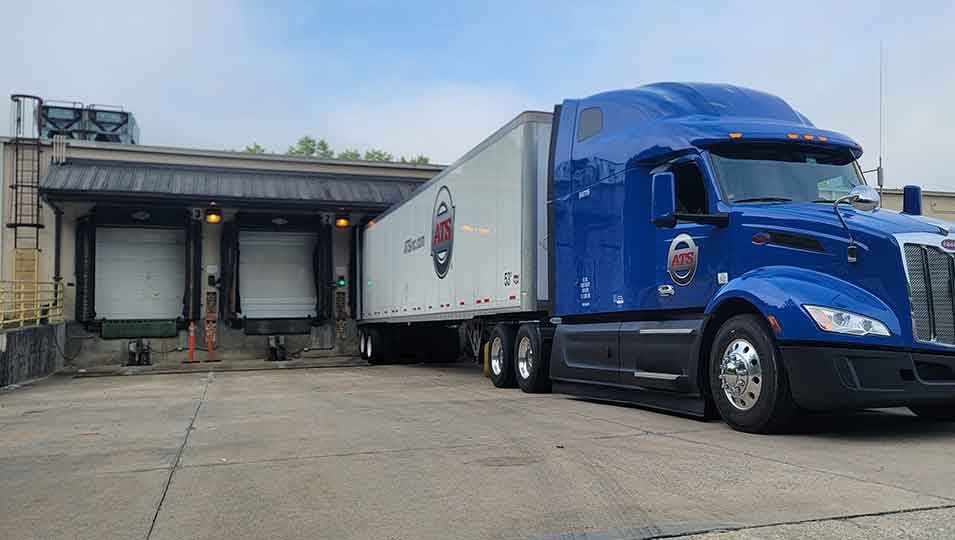
- First come, first served (FCFS) definition, pros & cons
- Appointment scheduling definition, pros & cons
- How to choose a freight scheduling method
In the transportation industry, there are an infinite number of goods to pick up or deliver: toilet paper, apples, couches, industrial air conditioners — the list goes on.
There’s also an infinite combination of pickup and delivery locations, trucks, drivers, routes and other variables.
All of these infinite scenarios include one of two methods for pickup/delivery scheduling: first come first serve (FCFS) or by appointment.
Although these two strategies for pickup and delivery scheduling are fairly easy to define, the ramifications for drivers, carriers, shippers and receivers are huge. Are you sure you understand what each method means for each of these parties?
While the number of pick ups and deliveries we have completed at Anderson Trucking Service (ATS) is not quite infinite, we handle hundreds of truckloads every day. Working with each company’s logistics manager has given us a thorough understanding of how both systems work, and their advantages and disadvantages.
After reading this article, you will understand each method, their pros and cons, and what they may mean for the supply chain. With this information, you will be armed to make the best choice when it comes to dealing with freight on a regular basis.

What Is FCFS in Trucking?
In an FCFS system, also called “open scheduling,” the first truck to arrive at a location is the first one to be loaded or unloaded. There is no need for carriers to arrange a time for their driver to arrive — they simply clarify what time the facility is open, and direct their driver to arrive during that window.
At a facility that operates using FCFS, drivers check in and then line up based on when they arrive. When one truck leaves the loading area, the next truck pulls up and is loaded or unloaded. There is no delay between trucks.
Advantages of FCFS
FCFS eliminates the need for appointments and the stress of missed appointments. Especially at busy shipping and receiving facilities, there may be a constant stream of trucks pulling in to load, with little to no downtime in between.
Drivers don’t have to worry when traffic, weather or breakdowns cause delays. With FCFS, trucks are loaded/unloaded in the order they arrive, giving them flexibility to deal with slowdowns or delays throughout the day.
FCFS can also streamline operations at the destination point. While a missed appointment can mean waiting to load/unload until the next scheduled arrival, with FCFS the staff simply moves on to the next truck in line.
When using appointment scheduling, workers stage each load in the order it will move based on the day’s appointments. With FCFS, there is no staging. The warehouse is always organized to expedite the loading/unloading process, without floor space dedicated to staged loads that haven’t yet been picked up.
Of course, no system is perfect. While FCFS works at many facilities, there are drawbacks that may mean it’s not the best choice for you.
Disadvantages of FCFS
While FCFS means more flexibility with trucks arriving and departing, the disadvantages of the system relate to the lack of structure created by trucks showing up at any time of the day.
Busy (or unorganized) facilities may have long wait times before an arriving truck can be loaded or unloaded. Every hour drivers spend waiting around counts against their mandated Hours of Service.
Long lines also make it harder for both the drivers and the warehouse staff to plan breaks. When they are working around existing appointments, it’s easy to look at the daily schedule and determine when there is time for a break. With FCFS, there is no set downtime — and you risk timing breaks just before a truck pulls in for loading.
FCFS also makes it impossible to prioritize particular freight. When you are bound to send trucks out in the same order they arrive, there is no wiggle room to move a truck ahead in line to prioritize a higher-value shipment.
If many trucks are waiting in order of arrival, FCFS may require more parking or yard space than is easily available. Smaller facilities that only have room for one truck at a time may not be able to accommodate multiple trailers waiting to unload.
Understanding FCFS is one step in determining the best scheduling method for your facility. Comparing it to appointment-based scheduling will give you the full picture of both options and help you make your decision.
Appointment Scheduling in the Trucking Industry
With appointment scheduling, each load has a scheduled time to arrive at a location. Drivers pull up at their appointed time and a team of workers gets to work loading and unloading the truck.
At by-appointment facilities, everyone is working under the same plan. The driver manager schedules the appointment based on the number of miles the driver is expected to travel daily and communicates that with the driver while they are planning the route.
The advantages and disadvantages of appointment scheduling are often the reverse of the advantages and disadvantages of FCFS. But of course, there are some nuances to consider.
Advantages of Appointment Scheduling
Appointment scheduling creates a predictable schedule for all involved. The driver knows their appointed time and can schedule their driving hours and breaks based on it. The warehouse manager can schedule staff and breaks around the day’s plans.
Larger warehouses can use some floor space to stage outbound loads. Laying everything out in the order to load helps everyone understand what needs to be done when the truck arrives. This can speed up the loading process.
This system can also benefit facilities that do not have a large area for trucks to wait in line. Especially if there is a nearby truck stop, drivers do not need to appear on site before their scheduled appointment.
Disadvantages of Appointment Scheduling
Appointment scheduling relies on everyone meeting their deadlines and running on time. The main disadvantage of this system is that missed appointments and deadlines can cause a range of problems.
Drivers who are late or miss their scheduled appointment may not be able to load/unload that day, potentially causing problems with future deliveries.
Late or missed appointments can also complicate the day for the logistics manager. Staff may have to work overtime or reschedule breaks to accommodate the new appointment time. Freight that was staged for loading may need to be moved or worked around until that appointment can be rescheduled.
Especially if multiple loads are expected on the same day, one late appointment can start a domino effect that means all trucks are late, causing delays with future appointments.
With a thorough understanding of both systems and the pros and cons of both systems, you may be prepared to decide which scheduling method is best for you. If you’re still on the fence, there are a few additional considerations that can help.
FCFS vs. Appointment: Which Logistics Scheduling Should I Choose?
Of course, there’s no one right answer for which type of scheduling is best. After comparing the pros and cons of each system, there are some additional factors you may want to consider — including:
- Number of expected deliveries. Operations who expect multiple truckloads every day may benefit from the organization of appointment scheduling. If you are expecting just a few shipments each week, the flexibility of FCFS may work better.
- Available space. If you are operating with a limited amount of space for staging and loading, FCFS may help you operate within your footprint. Larger facilities with plenty of room for staging and multiple loading docks may prefer the organization of appointment scheduling.
- Type of business. Consider how other operations work at your facility. For example, appointment-based scheduling uses many of the same practices as assembly lines, so that may be helpful for your staff. If your staff is used to flexing their schedules, FCFS may be easier for them.
- Staffing. FCFS shipments require staff onsite to load and unload freight at all times. If you do not have a full-time team onsite who can handle this, you may need to schedule appointments and have staff available only at those times.
- Price. Just kidding! This is one of the few decisions shippers have to make that does not impact the price of moving a load. Note, however, that if you use appointment scheduling and delays keep the driver at your facility for more than two hours, you may be billed a detention fee.
Once you have determined how your facility will work, be sure to communicate your scheduling system clearly with all carriers coming in and out. They will prepare for your load based on these requirements.
In the trucking industry, clear communication saves everyone time (and money). If you’re ready to schedule a load with ATS, we’re delighted to help you.





